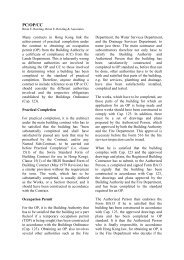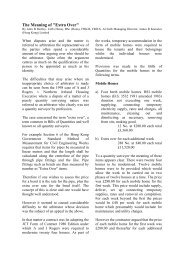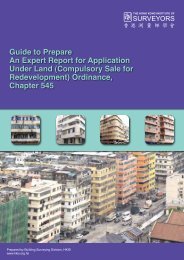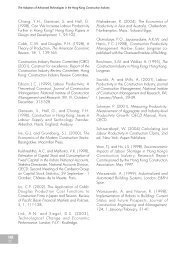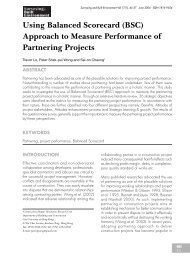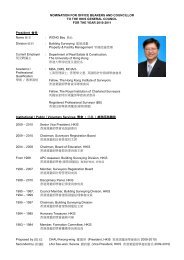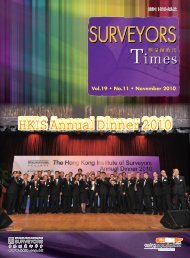Special issue to commemorate the 70th Anniversary of the Battle of ...
Special issue to commemorate the 70th Anniversary of the Battle of ...
Special issue to commemorate the 70th Anniversary of the Battle of ...
Create successful ePaper yourself
Turn your PDF publications into a flip-book with our unique Google optimized e-Paper software.
Chinese Eyes on British Tanks: His<strong>to</strong>rical Verification <strong>of</strong> a War Heritage<br />
because I feel sure it would gratify not only <strong>the</strong><br />
giver, but all <strong>the</strong> Chinese in <strong>the</strong> Malay States and<br />
likely lead <strong>to</strong> <strong>the</strong> gift <strong>of</strong> ano<strong>the</strong>r tank. (Eu 2008:9)<br />
And <strong>to</strong> preempt any attempt from <strong>the</strong> lower army<br />
hierarchy <strong>to</strong> resist his boss’ idea, he added:<br />
I can barely suppose that <strong>the</strong> War Office would<br />
consider <strong>the</strong> addition <strong>of</strong> <strong>the</strong> eyes would make <strong>the</strong><br />
tank so conspicuous that <strong>the</strong>y must be painted out,<br />
but one can never tell. (Eu 2008:9)<br />
As letters were exchanged between <strong>the</strong> Official Press<br />
Office and <strong>the</strong> Colonial Office, <strong>the</strong> production <strong>of</strong><br />
<strong>the</strong> important Mark IV tanks, which began in early<br />
March, proceeded in earnest. Because <strong>of</strong> a variety <strong>of</strong><br />
political, technical and logistical reasons, new Mark<br />
IV tanks were initially produced at a rate <strong>of</strong> only 20<br />
tanks a week. (Fletcher 2007:4) As soon as <strong>the</strong>y rolled<br />
out from <strong>the</strong> production lines in England, <strong>the</strong>re was<br />
a pressing need <strong>to</strong> dispatch <strong>the</strong>m across <strong>the</strong> English<br />
Channel <strong>to</strong> France, where <strong>the</strong>ir numbers could be built<br />
up for <strong>the</strong> planned Cambrai <strong>of</strong>fensive. The first batch<br />
<strong>of</strong> 19 Mark IV tanks (with War Department numbers<br />
2001 <strong>to</strong> 2019), which came <strong>of</strong>f <strong>the</strong> same production<br />
lines at <strong>the</strong> Foster plant in Lincoln as Tank 2341,<br />
reached France on <strong>the</strong> night and early morning <strong>of</strong> 17-<br />
18 April. (Campbell 2008: 266, 268) Like o<strong>the</strong>r new<br />
tanks, <strong>the</strong>y would be tested and fitted out at <strong>the</strong> Central<br />
Workshops in Erin before being assigned <strong>to</strong> <strong>the</strong>ir<br />
designated tank units.<br />
In June 1917, <strong>the</strong> War Office finally gave in <strong>to</strong><br />
Swettenham, and was prepared <strong>to</strong> retrospectively add<br />
eyes <strong>to</strong> <strong>the</strong> tank donated by Eu Tong Sen. However,<br />
it would have been impossible <strong>to</strong> carry out <strong>the</strong> work<br />
in Britain, as Tank 2341 had by this time already been<br />
shipped <strong>to</strong> France and <strong>issue</strong>d <strong>to</strong> F Battalion <strong>of</strong> <strong>the</strong><br />
Tank Corps. The painting would have <strong>to</strong> be carried<br />
out on French soil. But who was responsible for<br />
painting <strong>the</strong> eyes on Tank 2341? The author would<br />
like <strong>to</strong> hypo<strong>the</strong>size that it was a member <strong>of</strong> <strong>the</strong> Chinese<br />
Labour Corps – Chinese contract labourers serving<br />
with <strong>the</strong> British Army in World War I – who worked at<br />
<strong>the</strong> Camouflage Section <strong>of</strong> <strong>the</strong> Erin Central Workshops.<br />
The Camouflage Section was at <strong>the</strong> time staffed by 70<br />
members <strong>of</strong> <strong>the</strong> Chinese Labour Corps and was tasked<br />
with <strong>the</strong> painting <strong>of</strong> all tanks.<br />
An overlooked piece <strong>of</strong> evidence that strongly<br />
suggests that eyes were <strong>the</strong> handiwork <strong>of</strong> a member<br />
<strong>of</strong> <strong>the</strong> Chinese Labour Corps is <strong>the</strong> fact that <strong>the</strong> eyes<br />
proposed by Swettenham were those painted on<br />
Chinese fishing boats, which were supposedly fish<br />
eyes. Chinese Labour Corps members were typically<br />
nor<strong>the</strong>rn Chinese from <strong>the</strong> inland areas <strong>of</strong> Shandong<br />
province, and such a person assigned <strong>to</strong> <strong>the</strong> painting<br />
job would have little idea about <strong>the</strong> maritime tradition<br />
<strong>of</strong> sou<strong>the</strong>rn China. Having no reference <strong>to</strong> <strong>the</strong> painting<br />
order, which probably did not specify <strong>the</strong> particular<br />
kind <strong>of</strong> eyes, <strong>the</strong> painter from Shandong painted a pair<br />
<strong>of</strong> human eyes. The eyes were apparently European<br />
in that <strong>the</strong>y featured folded eyelids and blue irises, and<br />
one can speculate that <strong>the</strong>y were perhaps modelled on<br />
<strong>the</strong> eyes <strong>of</strong> <strong>the</strong> painter’s supervising British <strong>of</strong>ficer! 9<br />
Notwithstanding <strong>the</strong>ir distinctive European features,<br />
from <strong>the</strong>n on <strong>the</strong>y would always be known as “Chinese<br />
Eyes” because <strong>of</strong> <strong>the</strong> Chinese connection <strong>to</strong> <strong>the</strong><br />
conceptual origin and artistic execution.<br />
WHAT HAPPENED TO TANK 2341<br />
DURING THE WAR? 10<br />
The common s<strong>to</strong>ry <strong>of</strong> what happened <strong>to</strong> Tank 2341 in<br />
France is a schizophrenic tale <strong>of</strong> confused identities. 11<br />
After being tested and fitted out in Erin, Tank 2341 was<br />
assigned <strong>to</strong> 12 Section, 18 Company, F Battalion <strong>of</strong><br />
<strong>the</strong> Tank Corps. The tank, according <strong>to</strong> <strong>the</strong> common<br />
s<strong>to</strong>ry, was <strong>the</strong>n named “Fly Paper” and assigned <strong>the</strong><br />
tactical number <strong>of</strong> F56. F56 “Fly Paper” <strong>to</strong>ok part in<br />
<strong>the</strong> Third <strong>Battle</strong> <strong>of</strong> Ypres, which was launched on 31<br />
July 1917, with a crew under <strong>the</strong> command <strong>of</strong> Second-<br />
Lieutenant J. M. Oke (who survived <strong>the</strong> war and rose<br />
<strong>to</strong> <strong>the</strong> rank <strong>of</strong> Captain). 12 By <strong>the</strong> time <strong>of</strong> <strong>the</strong> <strong>Battle</strong> <strong>of</strong><br />
Cambrai, which began on 20 November 1917, F56 had<br />
somehow become transformed in<strong>to</strong> “Fan Tan” and had<br />
a different crew and a new commander, Lieutenant H.<br />
A. Aldridge (who also survived <strong>the</strong> war and rose <strong>to</strong> <strong>the</strong><br />
rank <strong>of</strong> Captain). 13<br />
This sketchy his<strong>to</strong>rical account <strong>of</strong><br />
<strong>the</strong> generally accepted version represents <strong>the</strong> extent <strong>of</strong><br />
what has hi<strong>the</strong>r<strong>to</strong> been known about Tank 2341.<br />
What could have actually happened <strong>to</strong> Tank 2341?<br />
Apparently, Tank 2341, christened “Fan Tan,” had in<br />
fact been held in reserve as a spare tank in F Battalion.<br />
It was <strong>the</strong>refore not assigned a tactical number, as only<br />
combat vehicles were so treated. 14<br />
The tactical number<br />
F56, which is <strong>of</strong>ten confusingly associated with “Fan<br />
Tan,” was indeed originally assigned <strong>to</strong> “Fly Paper.”<br />
But that tank was a different vehicle with an unknown<br />
War Office serial number. As F56 “Fly Paper”, this<br />
tank went in<strong>to</strong> action on <strong>the</strong> first day <strong>of</strong> <strong>the</strong> Cambrai<br />
campaign on 20 November 1917, and sustained a level<br />
9<br />
This is a conjecture. For an image <strong>of</strong> an eye <strong>of</strong> Horus or <strong>the</strong> eye <strong>of</strong> a Maltese luzzu, see respectively <strong>the</strong> images at<br />
http://www.google.com.hk/search?q=eye+<strong>of</strong>+Horus&hl=en&rlz=1W1SUNC_en&biw=1366&bih=528&prmd=imvns&tbm=isch&tbo=u&source<br />
=univ&sa=X&ei=Ck91TuSkLK-ZiAeZsMylDQ&ved=0CDwQsAQ and http://en.wikipedia.org/wiki/Luzzu<br />
10<br />
The main reference sources <strong>of</strong> this section are: <strong>the</strong> book War His<strong>to</strong>ry <strong>of</strong> <strong>the</strong> Sixth Tank Battalion (1919) and <strong>the</strong> website Landships (hosted by<br />
Google Sites at (http://sites.google.com/site/landships/), which carries referenced his<strong>to</strong>rical information on British tanks built between 1916 and<br />
1918.<br />
11<br />
This version <strong>of</strong> <strong>the</strong> s<strong>to</strong>ry is depicted in Fawcett 2001: 45 and Fletcher 2007: 45.<br />
12<br />
Captain J. M. Oke’s rank and name appear in <strong>the</strong> list <strong>of</strong> <strong>of</strong>ficers <strong>of</strong> <strong>the</strong> 6th (formerly F) Battalion <strong>of</strong> <strong>the</strong> Tank Corps; see: Somers 1919: 244.<br />
13<br />
Captain H. A. Aldridge’s rank and name appear in <strong>the</strong> list <strong>of</strong> <strong>of</strong>ficers <strong>of</strong> <strong>the</strong> 6th (formerly F) Battalion <strong>of</strong> <strong>the</strong> Tank Corps; see: Somers 1919:<br />
241.<br />
14<br />
See: <strong>the</strong> Landship website, page on spare tanks in F Battalion during <strong>the</strong> Cambrai campaign, at http://sites.google.com/site/landships/f-battalionspare-wire-pulling-and-supply-tanks-at-cambrai.<br />
SBE<br />
16




